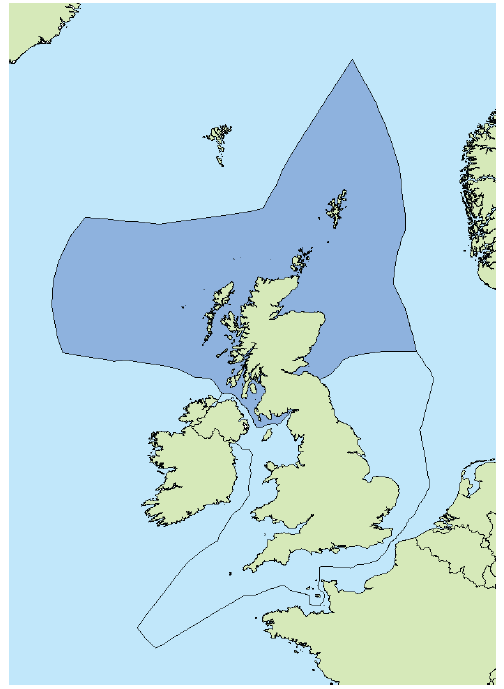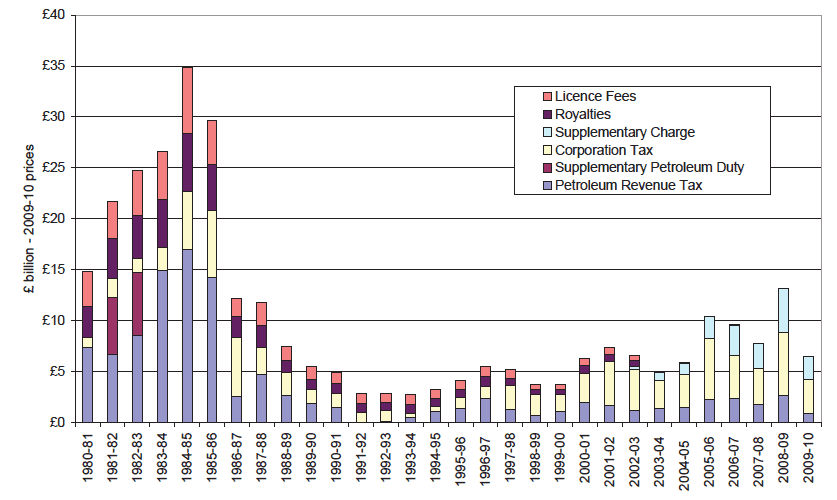Government Expenditure and Revenue Scotland 2009-2010
Government Expenditure and Revenue Scotland 2009-2010
5 NORTH SEA REVENUE
Introduction
This chapter provides a discussion of North Sea revenue and sets out the methodologies adopted in this publication.
The North Sea Fiscal Regime
North Sea revenue stems from three key sources: petroleum revenue tax, corporation tax and license fees.
For the period 2005-06 and 2009-10, the taxation or charging regime for each of these three elements was as follows -
1. Petroleum revenue tax ( PRT): PRT was charged at a rate of 50% on field-based profits from oil and gas extraction on fields given development approval prior to March 1993 at which time it was abolished for all new fields. There were deductions for all exploration, appraisal, and development costs on 100% first year basis with an uplift of 35% for field investment costs prior to field payback. There were also volume and safeguard allowances.
2. Corporation tax ( CT): Ring-fenced corporation tax was charged at a rate of 30%. There were deductions for exploration, appraisal and development costs on a 100% first year basis. In 2002, a Supplementary Charge ( SC) of 10% was introduced. This made the effective corporation tax rate ( CT + SC) 40%. From January 2006, the SC was increased to 20% making the overall tax rate 50% 22.
3. License Fees: The UK Government grants licenses for operators to "search and bore for and get" 23 petroleum in specified areas for a set period of time. Operators pay an annual fee for holding these licenses. License fees are charged at an escalating rate on each square kilometre that the licence covers. However, licence fees were gradually phased out over the period and, by 2008-09, no revenue was raised from this source.
North Sea revenue has been relatively volatile over the last two decades. Table 5.1 shows the North Sea revenue collected by the UK Exchequer since 1980-81.
Table 5.1: Total North Sea Revenue: UK 1980-81 to 2009-101, 2
Year |
£ million |
Year |
£ million |
Year |
£ million |
Year |
£ million |
|---|---|---|---|---|---|---|---|
1980-81 |
3,764 |
1988-89 |
2,616 |
1996-97 |
2,891 |
2004-05 |
5,183 |
1981-82 |
6,125 |
1989-90 |
2,007 |
1997-98 |
2,509 |
2005-06 |
9,384 |
1982-83 |
7,665 |
1990-91 |
1,979 |
1998-99 |
1,856 |
2006-07 |
8,924 |
1983-84 |
8,358 |
1991-92 |
647 |
1999-00 |
2,444 |
2007-08 |
7,464 |
1984-85 |
11,082 |
1992-93 |
858 |
2000-01 |
4,455 |
2008-09 |
12,925 |
1985-86 |
10,132 |
1993-94 |
1,047 |
2001-02 |
5,426 |
2009-10 |
6,491 |
1986-87 |
3,571 |
1994-95 |
1,374 |
2002-03 |
5,097 |
||
1987-88 |
4,055 |
1995-96 |
1,667 |
2003-04 |
4,284 |
1. Source ONS Public Finance Statistics
2. Note: gas levies are not included in total public sector revenue from the UK continental shelf because it is categorised as a tax on expenditure rather than an income from oil and gas production. Gas levies were abolished from 1 April 1998.
Table 5.2 shows the levels of revenue raised from the three key components of North Sea revenue since 2005-06.
Total North Sea revenue increased by 37.7 per cent between 2005-06 and 2008-09, reflecting the increase in wholesale oil and gas prices over this period and the higher supplementary corporation tax introduced in January 2006. However, between 2008-09 and 2009-10, North Sea revenue fell from £12.9 billion to £6.5 billion (49.8 per cent), as wholesale oil and gas prices fell significantly as a result of the global economic downturn.
Table 5.2: Composition of North Sea Revenue: UK 2004-05 to 2009-10
(£ million) |
|||||
|---|---|---|---|---|---|
2005-06 |
2006-07 |
2007-08 |
2008-09 |
2009-10 |
|
Licence fees |
61 |
60 |
56 |
0 |
0 |
North Sea corporation tax |
7,307 |
6,709 |
5,728 |
10,358 |
5,568 |
Petroleum revenue tax |
2,016 |
2,155 |
1,680 |
2,567 |
923 |
Total |
9,384 |
8,924 |
7,464 |
12,925 |
6,491 |
HMRC have revised the estimate of North Sea Corporation tax in 2007-08 from £6,095 million to
£5,728 million. Corporation tax figures for all other years in the table remain unchanged.
In the ONS Regional Accounts, the convention is for the UK Continental Shelf ( UKCS) to be included as a (notional) separate region of the UK (the extra-regio territory) and not to allocate this to specific geographic regions within the UK mainland.
A number of different approaches can be used to allocate a share of North Sea revenue to Scotland.
The following section presents a range of estimates of North Sea revenue that could be allocated to Scotland under various assumptions about the apportionment of the oil and gas industry.
Box 5.1 - Composition of UK North Sea Revenues
The structure and composition of the UK North Sea tax regime has varied significantly over the past 35 years. The chart below illustrates the total real terms tax revenue raised from North Sea oil and gas production, together with the revenue raised from each different element of the tax system. The chart illustrates that the importance of Petroleum Revenue Tax and Royalty payments has diminished since the mid 1980s, with an increasing proportion of revenue coming from corporation tax. Further information on the historic structure of the North Sea fiscal regime is available from the HMRC website 24. Government Revenues from UK Oil and Gas Production (2009/10 prices)
Source: HMRC and HM Treasury |
Scotland's Share of North Sea Revenue
For many years, there has been considerable debate on how the delineation of North Sea oil and gas output might be determined.
Three key estimates of Scotland's share of North Sea revenue are adopted in the GERS report -
1. Zero share
2. Per capita share
3. An illustrative geographical share
These are the figures which are used in the headline estimates of total public sector revenue in Chapters 3 and 4.
As the situation under option 1 is dealt with in the revenue estimates for all non-North Sea revenues, the discussion below focuses on per capita and geographical shares.
Per Capita Share
One interpretation of North Sea revenue is to view it as a non-identifiable UK revenue, in which case a per capita share may be apportioned to Scotland.
Table 5.3 provides an estimate of Scotland's share of North Sea revenue under this approach.
Table 5.3: Per Capita Share of North Sea Revenue: Scotland 2005-06 to 2009-10
(£ million) |
|||||
|---|---|---|---|---|---|
2005-06 |
2006-07 |
2007-08 |
2008-09 |
2009-10 |
|
Total North Sea revenue |
9,384 |
8,924 |
7,464 |
12,925 |
6,491 |
Scotland's per capita share |
793 |
754 |
629 |
1,088 |
545 |
Scotland's percentage share of North Sea revenue |
8.5% |
8.4% |
8.4% |
8.4% |
8.4% |
An Illustrative Geographical Share
An alternative approach is to apportion a geographic share of North Sea revenue to Scotland. In order to estimate this share, GERS draws upon academic research carried out by Professor Alex Kemp and Linda Stephen from the University of Aberdeen 25. Kemp and Stephen (2008) estimate Scotland's share of North Sea revenue based on a detailed financial model of the North Sea oil and gas industry and an assessment of Scotland's geographical share of the North Sea.
In their analysis, the researchers base the Scottish boundary of the UKCS on the median line principle as employed in 1999 to determine the boundary between Scotland and the rest of the UK for fishery demarcation purposes. Other alternatives are possible. Scotland's estimated geographical share of the North Sea sector, used in this report, is highlighted in the following diagram. Demarcation by the median line is highlighted by the dark shaded area in Figure 5.1. All oil and gas fields located in this region were apportioned to Scotland under the assumption of an illustrative geographical share.
Figure 5.1 UK Continental Shelf and Scottish Boundary

Source: Scottish Government Marine Directorate
Based on a detailed database of North Sea oil and gas fields, Kemp and Stephen estimated the tax revenue raised in each field. Their detailed modelling took account of production levels and a range of costs including research and development, and decommissioning. Taking the median line as the line of demarcation, the authors assigned revenue from each field to Scotland and the rest of the UK. The authors' most recent estimates show that Scotland's geographical share of oil production stood at 97 per cent in 2010, while its geographical share of gas production remained at 58 per cent. Scotland's share of total hydrocarbon production was 81 per cent in 2010, up marginally from 80 per cent in 2009.
Details of the methodology used by Kemp and Stephen are provided in the paper Kemp and Stephen (2008), 'The Hypothetical Scottish Shares of Revenues and Expenditures from the UK Continental Shelf 2000-2013' which is available from the weblink below. 26 Using estimates of Scotland's geographical share of total North Sea revenue, it is possible to apportion the total UK revenue figure from the ONS Public Sector Finance statistics to Scotland.
Table 5.4 provides estimates of Scotland's share of North Sea revenue using this methodology. It should be noted that the figures provided in Kemp and Stephen are on a calendar year basis. The estimates for financial years are calculated by first estimating the quarterly proportions using a cubic spline interpolation. These are applied to the quarterly revenue data, and summed to form the financial year estimates.
Table 5.4: Geographical Share of North Sea Revenue: Scotland 2005-06 to 2009-10
(£ million) |
|||||
|---|---|---|---|---|---|
2005-06 |
2006-07 |
2007-08 |
2008-09 |
2009-10 |
|
Total North Sea revenue |
9,384 |
8,924 |
7,464 |
12,925 |
6,491 |
Scotland's geographical share |
8,017 |
7,503 |
7,115 |
11,739 |
5,931 |
Scotland's percentage share of North Sea revenue |
85.4% |
84.1% |
95.3% |
90.8% |
91.4% |
Contribution to Current Revenue
Tables 5.5 and 5.6 show the estimated contribution to total Scottish current fiscal revenue from the North Sea in 2009-10, using a per capita and geographical share respectively.
Table 5.5: Current Revenue (Per Capita Share of North Sea Revenue): Scotland 2009-10
Scotland |
UK £ million |
Scotland as % of UK revenue |
||
|---|---|---|---|---|
£ million |
% of total revenue |
|||
Total current revenue (excluding North Sea revenue) |
42,201 |
98.7% |
506,669 |
8.3% |
North Sea revenue |
545 |
1.3% |
6,491 |
8.4% |
Total current revenue |
42,747 |
100.0% |
513,160 |
8.3% |
Table 5.6: Current Revenue (Geographical Share of North Sea Revenue): Scotland 2009-10
Scotland |
UK £ million |
Scotland as % of UK revenue |
||
|---|---|---|---|---|
£ million |
% of total revenue |
|||
Total current revenue (excluding North Sea revenue) |
42,201 |
87.7% |
506,669 |
8.3% |
North Sea revenue |
5,931 |
12.3% |
6,491 |
91.4% |
Total current revenue |
48,132 |
100.0% |
513,160 |
9.4% |
As Tables 5.5 and 5.6 highlight, the estimated size of current revenue in Scotland alters significantly depending on whether a per capita or an illustrative geographical share of North Sea revenue is apportioned to Scotland.
Assuming a per capita share, Scotland's estimated share of total UK current revenue remains at the same level as the share assuming the exclusion of North Sea revenue, that is, 8.3 per cent in 2009-10. In contrast, under an illustrative geographical share, Scotland's estimated share of total UK current revenue increased to 9.4 per cent in the same year.
There is a problem
Thanks for your feedback
